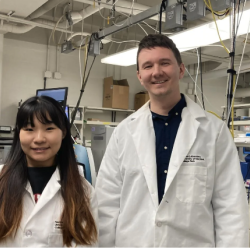Scientists Discover Method to Create and Trap Trions at Room Temperature
A UMD-led team chemically engineered carbon nanotubes to synthesize and trap trions—quasi-particles potentially useful in bioimaging, chemical sensing and quantum computing.
Trions consist of three charged particles bound together by very weak bonding energy. Although trions can potentially carry more information than electrons in applications such as electronics and quantum computing, trions are typically unstable at room temperature, and the bonds between trion particles are so weak that they quickly fall apart. Most research on trions requires supercooled temperatures, and even then, their fleeting nature has made trions difficult to control and hard to study.

A University of Maryland-led team of researchers has discovered a method to reliably synthesize and trap trions that remain stable at room temperature. The research makes it possible to manipulate trions and study their fundamental properties. The work is described in a research paper published in the journal ACS Central Science on October 16, 2019.
“This work makes synthesizing trions very efficient and provides a method for manipulating them in ways we haven’t been able to before,” said YuHuang Wang, a professor of chemistry and biochemistry at UMD and a senior author of the paper. “With the ability to stabilize and trap trions, we have the potential to build a very clean system for studying the processes governing light-emitting diodes and photovoltaics and for developing quantum information technologies.”
To read more, visit https://cmns.umd.edu/news-events/features/4499






